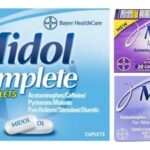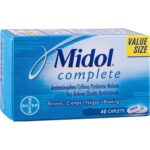How Long After Midol Can I Drink Alcohol?

Midol is a popular over-the-counter medication primarily designed to alleviate the symptoms associated with menstrual discomfort, such as cramps, bloating, and headache. While Midol can be an effective solution for many women, it is important to be aware of potential interactions with other substances, particularly alcohol.
Mixing medication and alcohol can have varying effects on the body, so understanding the timing and potential risks is crucial.
Midol and Its Effects
Midol typically contains active ingredients like acetaminophen (pain reliever), caffeine (a stimulant), and pyrilamine maleate an antihistamine (to alleviate bloating). These ingredients work together to provide relief from menstrual symptoms. While Midol is generally safe when taken as directed, combining it with alcohol may lead to unexpected consequences.
Timing Matters
The timing of when you can safely consume alcohol after taking Midol depends on several factors, including your body’s metabolism, the amount of Midol ingested, and the type of alcohol you plan to consume. It’s generally advised to wait at least 4 to 6 hours after taking Midol before drinking alcohol. Some doctors recommend waiting for at least 24 hours after the last dose of Midol before consuming alcohol.
Reasons to Wait
To fully understand the potential risks and interactions between Midol and alcohol, it’s essential to understand the specific mechanisms behind these concerns.
1. Liver Metabolism: The liver plays a pivotal role in metabolizing both Midol’s acetaminophen and alcohol. Alcohol can hinder the liver’s ability to process substances effectively, including acetaminophen. When the liver is occupied with breaking down alcohol, it may not efficiently clear acetaminophen from the body. This can lead to an increased concentration of acetaminophen in your system, which is concerning because excessive acetaminophen can be toxic to the liver, potentially causing liver damage. It is crucial to minimize the risk of overloading the liver by allowing sufficient time between consuming Midol and alcohol.
2. Digestive System: Alcohol is known to irritate the stomach lining, a potential side effect that can exacerbate gastrointestinal discomfort when combined with Midol. The caffeine and antihistamine in Midol can also have irritant effects on the stomach. Therefore, mixing alcohol and Midol may amplify these irritations, leading to a heightened risk of nausea, indigestion, or stomach upset. This can make the experience of using Midol less effective and even less comfortable.
3. Drowsiness: Many variants of Midol contain antihistamines, which are commonly used to reduce allergic reactions and often cause drowsiness. When combined with alcohol, this drowsiness can be intensified, leading to a heightened risk of impaired motor skills and decreased alertness. Impaired cognitive function can affect an individual’s ability to react quickly and make informed decisions, potentially leading to accidents or poor judgment.
4. Overlapping Effects: Both Midol and alcohol have blood-thinning properties. Midol’s antihistamines can contribute to this effect by dilating blood vessels. When combined with alcohol, which can also thin the blood, there is an increased risk of bleeding or bruising. This becomes particularly concerning for individuals with conditions that affect blood clotting or those taking medications with similar effects. The potential for prolonged bleeding is a serious issue and should be considered when mixing Midol and alcohol.
5. Increased Intoxication: Midol’s caffeine content can have stimulating effects, such as increased heart rate and alertness. These effects may mask the depressant effects of alcohol, leading individuals to feel more awake and alert than they actually are. This can result in a false sense of sobriety, causing individuals to overconsume alcohol. Increased alcohol consumption can lead to a range of dangers, including alcohol poisoning, impaired judgment, and an increased risk of accidents.
Consult a Healthcare Professional
If you are unsure about how Midol may interact with alcohol or if you have concerns about your personal health, it is always advisable to consult a healthcare professional or a pharmacist. They can provide personalized advice based on your medical history, any other medications you are taking, and your overall health.
Alternatives to Consider
If you want to enjoy a social drink and find yourself in need of menstrual symptom relief, consider alternatives to alcohol. Engaging in non-alcoholic beverages, such as herbal teas, can be a safer option when using Midol. These beverages can also provide comfort and relaxation during your menstrual cycle.
Conclusion
While it is generally safe to consume alcohol in moderation after taking Midol, it is essential to be cautious and consider the timing of consumption. Waiting at least 4 to 6 hours after taking Midol is advisable to minimize potential risks. Always consult a healthcare professional if you have concerns about how Midol may interact with other substances, and remember to prioritize your health and well-being. Ultimately, your comfort and safety should be the top priorities during your menstrual cycle.





